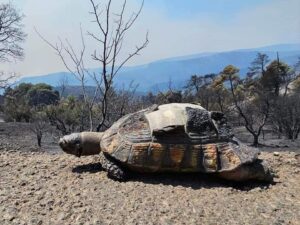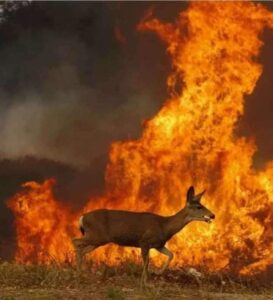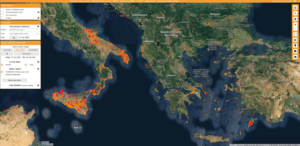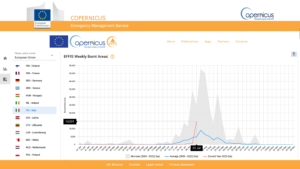



Photography: Anima, Greece
A historic long-lasting heatwave has been affecting the Mediterranean for about 2 weeks, breaking any previous records. The “impressive” June of 2023, was the warmest since 1979, raising the seasonal European average up to +0.73ο C, and the seasonal Global average over +0.53ο C (comparatively to the decade 1991-2020). In sequence, current extreme temperature values occur in Italy, Sardinia and Sicily. Since last Monday, a pick temperature value of 48.2°C, in Jersu, Eastern Sardinia, is from now on, the new European record for the month July.



Source: Climatebook, Meteo.gr and Effis
In Greece, a tense heatwave is threatening the country, setting in state of emergency, the entire island of Rhodes, after nine days of fighting the flames, with enormous destruction in many levels. Several areas of the island were evacuated, in a huge operational civil protection plan, with more than 19.000 residents being transferred elsewhere. Hundreds of Mega-fires have also broken out in Attica, Thessaly, Corfu Island and other territories.
Broadening the megafire incidents to the Mediterranean scale, here is to say that more than 40 people lost their lives in the last few days, while vast forest areas, villages and resorts are still burning. Thousands of people left their homes, ranchers have seen their animals burnt and farmers their crops destroyed, due to one of the most extreme heat waves in human history. This hazard, apart from environmental destruction, properties and even lives, has a huge impact on biodiversity loss. Thousands of rare, endemic species, innocent animal-souls are found charred, when impossible to get away, or saved by volunteers. We reside in their habitats, but they suffer from the human race’s wrong choices.
Recent megafires are surely exacerbated by climate change and socio-economic changes, land use changes, urbanization, etc. But, what exactly is happening to the Mediterranean?
Fires in the Mediterranean basin share a similar pattern, but not all the countries run the same risk. Every particular area, has it’s individual rate of vulnerability, which has to be taken into account.
Forests in north Mediterranean, cover almost 50% of total land regional area, but according to WWF, only 17% of this original forest cover, remains alive. Despite the modern firefighting systems, the risk of explosive fire waves, has been increasing in most countries.
The consequently environmental losses from rural fires affect an average of 500,000 hectares per year in Europe, of which 375,000 hectares pertain to Mediterranean countries. However, every 5 years, this area grows to about 700,000 hectares in Med-region.
Additionally, since 2017, for the first time in our latitudes, we are suffering a new type of mega-fire, unknown by the scientific community. Extreme, uncontrollable, lethal, surely accelerated by the global change. Most concerning is the fact that this phenomenon, seems to affect as well, all Europe countries like Sweden, Germany, Poland or the United Kingdom, historically not used to such forest fires.
The Intergovernmental Panel on Climate Change (IPCC) warns that Mediterranean ecosystems are among the world’s most vulnerable. The expected temperature increase will surely worsen the extreme climate episodes, due to parameters that can be summarized as follows:
• Alteration of fire patterns, as a combination of long heat waves, accumulated droughts, low humidity in the air and strong winds, together with a very dry vegetation and very flammable forests.
• Longer periods of risk and less seasonal related. Summers last approximately five weeks more than 40 years ago. In 2017, June and October have been the most critical months for the deadly fires that devastated Portugal and north Spain. According to Greek National Observatory, fire risk days in Greece will increase to 30 days more, in the coming 80 years. Normally fire period lasts from May to October, but recently, several regions in south, define the fire period from April to November.
Apart from environmental impact, and beyond human loss as the ultimate hazard, these lethal forest fires threaten the exceptional biodiversity of the Mediterranean to an extent that should be evaluated in detail: protected areas burnt, habitats’ destruction, species of interest lost, volume of CO2 released, impacts on hydrological balances and water quality or irreparable losses of fertile land.
By May 2019, fire disasters were multiplied by eleven times than usual, with a result of 40% increase of the area burnt, compared to the whole of 2018. This represents economic losses of about 3 billion euros per year, for the whole continent, while it is estimated that for the unfavourable scenario of 2070-2100, the economic impact of fires in Greece, Spain, France, Italy and Portugal may reach 5 billion euros per year (Source: EFFIS, EC PESETA II project report, Analysis of forest fire fatalities in Southern Europe).
2023 seasonal trends, according to the European Forest Fire Information System (EFFIS)
Greece has already exceeded the 2006-2022 period in July’s seasonal trend which was an average of 5.259 ha, with the vast area of 39.121 ha already been burnt for this year.

Likewise, in Italy the burnt area is 14.530 ha until now, compared to the average seasonal trend of 2006-2022 which was 9.037 ha.

According to the European Union’s Civil Defense Mechanism, fire incidents are the most frequent emergency up to now: from 2007 to 2018, 79% of the activations were due to forest fires.
As a supplement in May 2019, the European Commission launched “RescEU”, a specific reserve that includes aircrafts and other means for fire suppression. However, this mechanism not only serves to move means and water, but also to share the knowledge available. Teams of experts are preparing to offer their services to the countries and allow for an exchange of experiences.
Speaking of anticipation at a European Community level, a common forestry policy should be provided, with integral guidelines for the preservation of forests, fire-prevention and adaptation. For an effective protection against fires, we should invest in a responsible forestry management adjusting to climate change, more than creating a powerful firefighting system.
The cost of fire management in the Mediterranean region amounts to more than 2.000 million euros per year. On average, 80% is used for suppression, while 20% goes to prevention, prioritizing the construction or reconditioning of forest roads and paths, fire lines, water points or aircraft bases. These suppression measures are important if well planned, but they do not contribute to a wider forest-management policy.
At the national level, apart from reducing the landscape’s flammability, implementing a solid fire-prevention strategy, and improving civil defense capacities, governance should decrease the high incident rate, getting to know the causes and motivations, sentencing to dissuade potential perpetrators.
Regional or local authorities should provide a fire prevention strategy with a consistent follow-up system for the enforcement of policies’ implementation. Raising risk awareness will be achieved through educational programs, addressed to both urban and rural populations. This will link to social prevention, with interventions adjusted to the territorial needs.
Risk culture education is the key to transform attitude, towards self-responsibility and self-protection. Citizens must incorporate in their daily routine, the responsibility of living in urban-forest interface areas and apply self-protection plans not only in their property, but to all natural resources.
There is no longer any doubt that climate crisis calls for cross-border, shared and adapted solutions. Reducing uncertainty and increasing capacity against climate change, seems now to be crucial, more than ever. But even with the money and infrastructure in place, without change of human-attitude, there will be far-reaching impacts on the most sensitive ecosystems, critical loss of biodiversity and significant Mediterranean, European and Global threats.
Source: WWF, IPCC and Greek Observatory
Written by: Ermioni Gialiti, Natural Heritage

